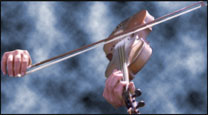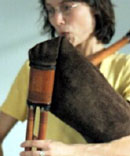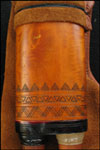
JigTime International

Other Links
Picture
Galleries
Merlefest
Altan in Ohio
Jeff
Beck and BB King
Ricky Skaggs and the Chieftains
HarvestFest
Bagpipes- A Contemporary Instrument Presentation - By Isabelle Devaux
 Bagpipes are often associated with Celtic music, and
it is true that many types emanate from Celtic lands, e.g. Scotland,
Ireland, or Brittany in France. But there are also bagpipes in countless
other countries: to name but a few, there is the Gaita in Galicia, Spain,
the Zampogna in the south of Italy, pipes in Greece and Portugal, and
many varieties exist in eastern Europe e.g. in Bulgaria, Croatia and
Hungary. One of the supreme and most beautiful of bagpipes are the Irish
Uilleann (the Irish word for elbow) pipes of Ireland, so named because
of the bellows used to supply the air to play them.
Bagpipes are often associated with Celtic music, and
it is true that many types emanate from Celtic lands, e.g. Scotland,
Ireland, or Brittany in France. But there are also bagpipes in countless
other countries: to name but a few, there is the Gaita in Galicia, Spain,
the Zampogna in the south of Italy, pipes in Greece and Portugal, and
many varieties exist in eastern Europe e.g. in Bulgaria, Croatia and
Hungary. One of the supreme and most beautiful of bagpipes are the Irish
Uilleann (the Irish word for elbow) pipes of Ireland, so named because
of the bellows used to supply the air to play them.
Bagpipes are old
instruments, and their origins are difficult to determine. Although we
do not have extant instruments going quite so far back, we can trace
the bagpipe to at least the 12 th century and earlier through historical
iconography. They are still most frequently made of natural materials
such as ebony, boxwood, horn and leather. The melody pipe is referred
to as the “chanter”, which has finger holes and on which the
tune is played, and there are other additional pipes called “drones” that
give a continuous harmonic accompaniment under the melody. Each of these
pipes has a reed inside. There is a bag carried under one arm, and the
musician supplies the air to the bag of the pipe by either blowing into
a blow pipe with the mouth, or by pumping a bellows strapped to the waist
and attached to the other arm. Once a reservoir of air is supplied to
the bag, the piper puts pressure on the bag and the air under pressure
then passes over the reeds and out of the ends of the various pipes.
The air from the bag travels down the pipes and passes over the reeds,
making them sound. The hardest part is to maintain a consistent pressure
to keep the notes in tune.
Bagpipes have an unusual symbolism. Some old pictures show bagpipes as an instrument from the heavens ( http://jeanluc.matte.free.fr ). Soldiers over the centuries have described the Scottish military piping bands, which led their army's attacks, as the sound of hell itself. The sound of the bagpipes has even been described in a romantic way. The French writer Georges Sand, in her novel “Les Maitres Sonneurs,” describes in detail the lifestyle and musical culture of a group of lumberjack-pipers, who used to travel around one of the biggest forests in the middle of France.
 In the days before recording equipment appeared at the
end of the 19 th century, traditional music was taught by ear from one
generation of players to the next. That repertoire, the playing style,
and the instruments used, were mainly related to the popular lifestyle
in each community. At that time, music was mostly played for dancing.
The tunes of those traditions, and the dances that went with them, could
differ from one country to another – even from one region to another within a given country.
Even now, in France, people dance “Andro” in Brittany, but they dance
the completely-different “Bourree” in Auvergne.
In the days before recording equipment appeared at the
end of the 19 th century, traditional music was taught by ear from one
generation of players to the next. That repertoire, the playing style,
and the instruments used, were mainly related to the popular lifestyle
in each community. At that time, music was mostly played for dancing.
The tunes of those traditions, and the dances that went with them, could
differ from one country to another – even from one region to another within a given country.
Even now, in France, people dance “Andro” in Brittany, but they dance
the completely-different “Bourree” in Auvergne.
In the 20 th century, the huge popularity of jazz, and later rock, almost obliterated folk-dance and other traditional music in several European countries like France, Germany, and England. In Ireland or Quebec, where the cultural identity is well integrated into the popular society, traditional music is still played in family sessions or pubs.
In the 1960s, the folk movement that began in the US spread to Europe, leading to a “revival” of interest in traditional music. Instrument making became popular again, and the quality of well produced folk instruments flourished. Pop music influenced folk musicians, and vice versa. In Ireland, for example, bands like Planxty and the Bothy Band began a new musical trend that influenced a whole generation.
Nowadays, traditional music is played around the world by the children of that “revival” generation. Their main interest seems to be musical creativity, moving beyond the music's social function. Some Celtic bands, like Dervish, Lunasa, Danú, and La volée de Castor, remain faithful to a traditional repertoire. Others explore some new sounds by fusing different styles of music (Kila, Tuna). These days, people have coined the phrase “world music” for the blending of what people from around the world recognize as their own traditional music.
Traditional musical practices have taken different orientations that can satisfy several audiences. They exist in several musical vogues and they are in the media. Despite that, some questions remain current: what is the function of traditional music nowadays? Do the traditions still belong to specific cultural communities? In fact, traditional music from even the smallest village has become a piece of the world's cultural community.
Bagpipes are one of the oldest traditional musical instruments, travelling though the centuries carrying pieces of history to the modern world. The sound of the bagpipes evokes the memory of a popular historical heritage, coming from the old world into the present.
Support JigTime and
keep our banner ads limited to those that lead you to the music
you love |